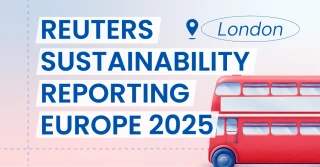Novisto at Sustainability Reporting Europe 2025: Key takeaways

Held on June 10-11, 2025, Reuters Sustainability Reporting Europe 2025 brought together over 300 sustainability, finance, and legal leaders from diverse companies and institutions such as Microsoft, AstraZeneca, and the European Parliament. The event responded directly to growing market needs: more case studies, more hands-on workshops, and more meaningful engagement with solution providers, all with a focus on tackling real-world reporting challenges.
The two-day agenda addressed the ongoing complexity of the CSRD, EU Taxonomy, and CSDDD, highlighting the urgency for companies to invest in new systems, internal processes, and ESG data capabilities. From navigating double materiality assessments to exploring how AI can streamline data workflows, the sessions emphasized practical steps to enhance resilience and unlock long-term value. Novisto took part in the discussions and connected with leaders driving the evolution of corporate sustainability reporting across Europe.
Top 5 insights
#1 ESG reporting overload: Internal chaos meets framework fatigue
Booth conversations and panel discussions revealed a shared reality across many organizations. ESG reporting has become overwhelming, both within companies and across the broader reporting landscape. First-time CSRD reporters in particular expressed uncertainty around what’s truly required, while juggling siloed spreadsheets, limited internal capacity, and increasing regulatory expectations.
At the same time, attendees voiced frustration over the lack of alignment between standards like ISSB, ESRS, GRI, and CDP. With no unified framework, many are struggling to tell a consistent ESG story. The call for clarity, structure, and purpose-built tools that simplify reporting without sacrificing accuracy is stronger than ever.
#2 From silo to strategy: Embedding ESG across the organization
Speakers emphasized the importance of aligning sustainability strategy with overall business objectives, rather than treating it as a separate function. With CSRD placing a strong emphasis on auditability, companies are using this time to ensure that systems, teams, and internal processes are properly structured. There was a shared understanding that building a compliant and future-ready ESG foundation requires early coordination and a clear focus on material topics.
#3 Audit pressure: navigating the balance with ESG’s core mission
Speakers in several sessions raised concerns that CSRD implementation is becoming overly compliance-focused. As one speaker highlighted, their primary audience for sustainability reports is now their auditor, which is not the spirit of what these reports were meant for. This directly reflects a growing divide between the intent of CSRD (strategic ESG) and how it’s being executed (tick-box compliance). Multiple speakers expressed concern that the original purpose of linking sustainability to long-term value is being lost under audit pressure, with the risk that it turns into a mere box-ticking routine. This critical shift underscores the urgent need to realign reporting efforts with strategic goals rather than focusing solely on audit expectations.
#4 Nature-related risks are still being overlooked
Nature-related risks like drought, biodiversity loss, and supply chain disruptions emerged as a recurring theme. Yet, some companies are approaching these topics too superficially, often excluding them from materiality assessments without supporting data. Speakers emphasized that nature impacts are hyper-local and require better tools to measure and report.
Moreover, a compelling opportunity lies in tools that extract deep site-level environmental data, leverage remote sensing or third-party datasets, and enable teams to conduct structured materiality assessments more effectively. As expectations around nature and value chain disclosure grow, companies will need smarter solutions to capture risks beyond their direct operations.
#5 High expectations for AI to ease ESG workloads
While regulatory pressure continues to rise, many attendees showed strong interest in how AI and automation could help reduce the manual burden of ESG reporting. This was especially true for teams dealing with supplier data collection, where time-consuming coordination and inconsistent formats remain a major challenge. Furthermore, there’s growing recognition that scalable AI solutions will be essential to keep up with reporting demands without overloading internal teams.
Ultimately, the demand for smarter, tech-enabled workflows is growing fast, and ESG leaders are actively exploring tools that can do more of the heavy lifting.
H2. Accelerate your ESG reporting transformation
Reuters Sustainability Reporting Europe 2025 highlighted the urgency and complexity of today’s reporting landscape as well as the opportunities ahead. Companies that embrace structured, data-driven ESG processes are not just meeting compliance needs, they’re setting themselves up for long-term value and strategic impact.
Looking to simplify your CSRD journey? Novisto’s platform brings structure to ESG data chaos and empowers your team to report with confidence.
Book a 15-minute call to see how we can support your next phase of ESG maturity.